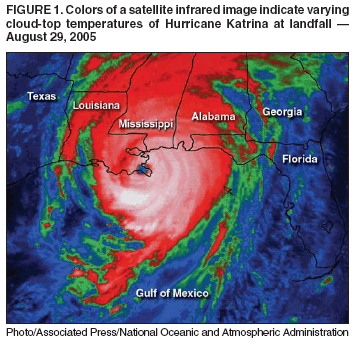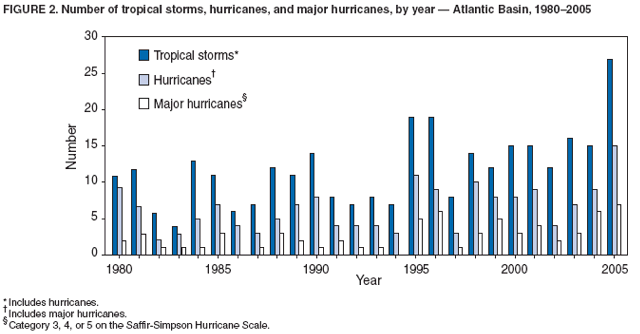 |
|
|
|
|
|
|
| ||||||||||
|
|
|
|
|
|
|
||||
| ||||||||||
|
|
|
|
|
Persons using assistive technology might not be able to fully access information in this file. For assistance, please send e-mail to: mmwrq@cdc.gov. Type 508 Accommodation and the title of the report in the subject line of e-mail. Public Health Response to Hurricanes Katrina and Rita --- United States, 2005On August 29, 2005, Hurricane Katrina struck the U.S. Gulf Coast, the eye making landfall at Plaquemines Parish, Louisiana (Figure 1). The events that followed made Katrina the deadliest hurricane since 1928 and likely the costliest natural disaster on record in the United States (1). Devastating storm surge, strong winds, and heavy rains caused widespread destruction in Louisiana, Mississippi, Alabama, and Florida (1). Storm-induced breeches in the levee system surrounding New Orleans flooded 80% of the city (1). The disaster was compounded when Hurricane Rita made landfall 26 days later near the Texas-Louisiana border, forcing cessation of hurricane-response activities in New Orleans and evacuation of coastal regions of Louisiana and Texas. The economic and health consequences of Hurricanes Katrina and Rita extended beyond the Gulf region to affect states and communities throughout the United States. MMWR is highlighting the public health response to Hurricanes Katrina and Rita with two special issues. The first issue, published January 20, 2006, focused on public health activities in Louisiana. This second issue focuses on activities in other states directly or indirectly affected by the two hurricanes. Hurricane activity is cyclical (2). Since 1995, the Atlantic Basin has been in an active hurricane phase, and the 2005 Atlantic hurricane season was the most active on record (Figure 2). Katrina was one of 27 named storms (i.e., tropical storms or hurricanes) observed in the Atlantic Basin (2), eclipsing the previous record of 21 set in 1933. Tropical storms are allotted an alphabetical listing of 21 names each year; these annual lists of names typically are reused every 6 years. However, during 2005, for the first time since this naming convention began in 1953, all 21 names were used, and Greek letters (i.e., Alpha, Beta, Delta, Epsilon, Gamma, and Zeta) were required to complete the naming. Tropical storm Zeta, which was observed on December 30 and dissipated on January, 6, 2006, was the last named storm of 2005 (2). The 2005 Atlantic hurricane season also was notable for the wind speed and intensity of the storms produced. During 2005, a total of 15 tropical storms became hurricanes (i.e., winds of >74 mph), and three of these (Katrina, Rita, and Wilma) reached Category 5 (i.e., winds of >156 mph) on the Saffir-Simpson Hurricane Scale (2). The previous record for number of hurricanes in a season was 12, set in 1969 (2). Only twice previously, during 1960 and 1961, had two hurricanes reached Category 5 in a single season (2). In 2005, for the first time on record, four major (i.e., Category 3, 4, or 5) hurricanes (Dennis, Katrina, Rita, and Wilma) made landfall in the United States. The intensity of a hurricane can be rated by its lowest central atmospheric pressure, as measured in millibars (mb). At 882 mb, Hurricane Wilma became the most intense hurricane ever measured (3). Previously, Hurricane Gilbert (888 mb), which struck Jamaica and the Yucatan Peninsula in 1988, had been the most intense hurricane (4). Two other 2005 hurricanes, Rita (897 mb) and Katrina (902 mb), became the fourth and sixth most intense Atlantic hurricanes on record, respectively (4). The impact of the 2005 Atlantic hurricane season and the combined effects of death, injury, destruction, and population displacement from Hurricane Katrina were unprecedented in U.S. history. With the Atlantic Basin predicted to continue in an active hurricane phase during the next 10--20 years, information from the reports in this issue and other issues of MMWR can document the public health impact of a major natural disaster and help guide future response and recovery activities. Reported by: WR Daley, DVM, Career Development Div, Office of Workforce and Career Development, CDC. References
Figure 1  Return to top. Figure 2  Return to top.
Disclaimer All MMWR HTML versions of articles are electronic conversions from ASCII text into HTML. This conversion may have resulted in character translation or format errors in the HTML version. Users should not rely on this HTML document, but are referred to the electronic PDF version and/or the original MMWR paper copy for the official text, figures, and tables. An original paper copy of this issue can be obtained from the Superintendent of Documents, U.S. Government Printing Office (GPO), Washington, DC 20402-9371; telephone: (202) 512-1800. Contact GPO for current prices. **Questions or messages regarding errors in formatting should be addressed to mmwrq@cdc.gov.Date last reviewed: 3/9/2006 |
|||||||||
|